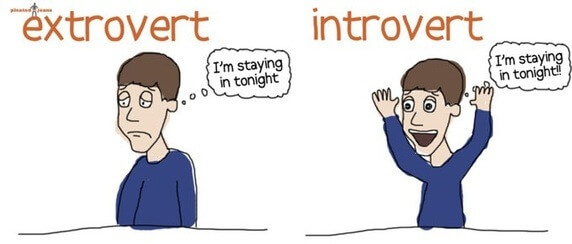I remember the first time I really learned what introversion and extraversion were. It was in a Psychology of Personality class during my sophomore year of college.
A Quick Psychology Lesson
We learned that when it comes to the realm of personality, there is a widely accepted theory of the “big five” personality traits. They are:
- Extraversion
- Agreeableness
- Conscientiousness
- Neuroticism
- Openness
Each of the traits runs on a spectrum, so you could be high in extraversion (and therefore an extrovert) or low in extraversion (and therefore an introvert).
When most people think generally of introversion vs. extraversion, they just think shy vs. outgoing. But it is far, far more complicated that that. Introverts and extroverts extract energy from different sources and each exhibit specific traits.

Introverts
The heart of introversion is the lack of need for external stimulation. It is easy for introverts to become overstimulated by external stimuli, which is why they often prefer to spend time alone. They are comfortable alone, and even crave alone time. They are reflective and often focused on internal thoughts, feelings, ideas, etc. They tend to have small, close knit groups of friends, and would rather spend time with them than with large groups of people/strangers (such as at parties).
Extroverts
On the other hand, extroverts crave external stimuli. They actively seek out what introverts try to escape from. They are very expressive, outgoing, and desire similar feedback from their environments. Therefore, they enjoy being around large groups of people having lots of friends. They are extremely comfortable in group settings.
So What Am I?
For a long time, I thought I was weird for wanting to stay in, or be alone. I thought I was anti-social, or maybe reclusive. But I still had a few close friends I liked to spend time with. Just not all my time. And was a little shy, but I found it fairly easy to have conversations with people, both friends and strangers.
I was so confused. Other people would comment on how outgoing and friendly I was, and yet I needed time alone to recharge and stay sane. When I was still thinking of introversion and extraversion as shy vs. outgoing, I thought I must be an extrovert. But I hated parties, didn’t care to talk to strangers or actively try to make new friends, and hated group projects.
In that psychology class sophomore year, I realized, once and for all, that I was an introvert.
“Introverting” When Your Friends are Extraverts
When I was living in a dorm during my freshman and sophomore years of college, I found it extremely difficult to find my alone time that I needed to recharge.

See, when you’re living with three other girls in dorm rooms, there’s always someone around. You have these built in best friends, and all they want to do is eat together, study together, hang out together…
Don’t get me wrong, I loved my friends. But I needed time to “introvert.” Time to watch my own tv shows with my headphones in, time to read and write for fun, time to just simply sit with my thoughts. And it was hard to find that time when living with others.
But once you realize that you are an introvert and need that time alone, you have to explain it to the people around you. You have to tell them that when you say “no” to going out with them on the weekend, it’s not because you don’t want to spend time with them, but because you just need some time away.
Personality Types
You can probably figure out whether you’re an introvert or extrovert just by reading the descriptions above, but there are also some pretty interesting and accurate personality tests you can take.
The Myers-Briggs personality test is one of the most well-known. It tests you on four different personality traits, each of which has two ends of a spectrum. This can lead to sixteen unique personality types (pictured below).

So what do all those letters stand for? Well the four main traits the Myers-Briggs tests for are:
- Favorite world – do you focus on your inner world or the outer world?
- Inner world = introversion (I)
- Out world = extraversion (E)
- Information – do you focus on the information you are given, or your interpretation of it?
- Basic information = sensing (S)
- Interpretation = intuition (N)
- Decisions – do you make decisions based on logic/consistency or the specific circumstances/people around you?
- Logic = thinking (T)
- Circumstances = feeling (F)
- Structure – when dealing with the outside world, do you have decided views, or do you keep a more open mind?
- Decided views = judging (J)
- Open mind = perceiving (P)
I’ve taken a few versions of the test online and each time I get this result: INFJ.
According to the Myers-Briggs website this makes me:
“Vision and meaning oriented. Quietly intense. Insightful. Creative. Sensitive. Seeks harmony, growth. Serious. Loves language, symbols. Persevering. Inspiring.”
Holy wow. For those of you who know me in person, I think you’d agree that this is an eerily accurate description of me. (Find more on INFJ here).
I encourage everyone to take a personality test like this one. It’s interesting to go beyond the introversion/extraversion trait (which so many people get caught up on) and learn even more about your traits. It’s good to know about yourself and who you are, and we don’t always have the best self-awareness.
So in closing, you’re not weird if you’re a teenager or young adult and you like spending time alone, don’t really like going to parties, and prefer to keep a close group of friends.
You’re not weird – you’re just an introvert!





